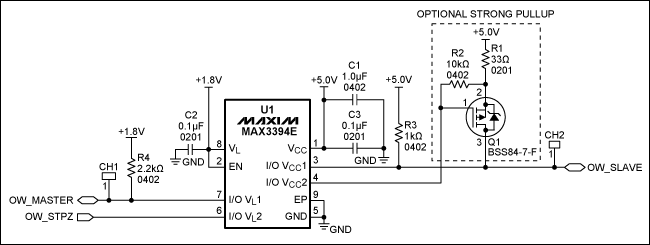

Reference Design of a 1-Wire B
RF/无线
1843人已加入
描述
Reference Design of a 1-Wire Bidirectional Voltage-Level Translator for 1.8V to 5V
Abstract: Designers need open-drain logic to run at 1.8V at the 1-Wire master IO. Most 1-Wire slave devices cannot run at 1.8V. This application note presents an RD (reference design) of a circuit that translates from a 1.8V 1-Wire master to a 5V 1-Wire slave device. The RD is used for driving typical 1-Wire slave devices. The MAX3394E voltage-level translator is featured in the design.
Introduction
Devices such as FPGAs, microprocessors, the DS2482-100, and DS2480B are examples of 1-Wire master devices. The 1-Wire/iButton® slave devices are manufactured by Maxim and comprise an extensive family of parts that typically operate from 2.8V to 5.25V. The 1-Wire masters and slave devices have traditionally been 5V open-drain logic in the past.Today designers need open-drain logic to run at 1.8V at the 1-Wire master IO. While most 1-Wire slave devices can run safely at 5V, most of those same devices cannot run at 1.8V. A bidirectional voltage-level translator circuit is needed to overcome this limitation. This RD (reference design) features the Maxim® MAX3394E, which is a bidirectional voltage-level translator for these applications.
Voltage-Level Translator
The MAX3394E is a dual-level translator available in an 8-pin, 3mm x 3mm TDFN package. It is ideal for driving high-capacitive loads, thanks to its internal slew-rate enhancement circuitry. 1-Wire slave devices often have capacitive loading greater than 500pF. The MAX3394E's VCC I/O pins are protected to ±15kV HBM (Human Body Model), which protects the 1-Wire master. The 1-Wire bus architectures often interface to the external world, making HBM essential. However, it is recommended that a DS9503P be added as ESD protection for the pullup resistor (R3), the optional strong pullup circuitry, and the 1-Wire slave device.Application Circuit
The circuit in Figure 1 shows the MAX3394E used to perform bidirectional 1.8V to 5V voltage-level translation in an open-drain system.
Figure 1. Schematic of 1-Wire bidirectional voltage level translation from 1.8V to 5V. Note that the pins I/O VL and I/O VCC have a typical 10kΩ internal pullup.
The BOM (bill of materials) for this reference design is given in Table 1.
Table 1. Bill of Materials
| Item | Quantity | Reference | Part | Manufacturer | Part Number |
| 1 | 1 | C1 | 1.0µF 0402 | Panasonic | ECJ-0EB0J105M |
| 2 | 2 | C2, C3 | 0.1µF 0201 | Panasonic | ECJ-ZEB0J104K |
| 3 | 1 | Q1 | BSS84-7-F | Diodes, Inc/Zetex | BSS84-7-F |
| 4 | 1 | R1 | 33Ω 0201 | Panasonic | ERJ-1GEJ330C |
| 5 | 1 | R2 | 10kΩ 0402 | Panasonic | ERJ-2RKF1002X |
| 6 | 1 | R3 | 1kΩ 0402 | Panasonic | ERJ-2RKF1001X |
| 7 | 1 | R4 | 2.2kΩ 0402 | Panasonic | ERJ-2RKF2201X |
| 8 | 2 | CH1, CH2 | TEST POINT | N/A | N/A |
| 9 | 1 | U1 | MAX3394E | Maxim | MAX3394EETA+ |
Waveform Measurements/Test Results
The test results in Figures 2 through 5 were generated from the board built for evaluating the circuit.Setup:
- VL = 1.8V
- VCC = 5.0V
- CH1: 1-Wire master (OW_MASTER)
- CH2: DS1920 (OW_SLAVE)
- OW_SLAVE wire length: 2.4m, max.
- Test results did not include the optional strong pullup circuitry in Figure 1.
- Room temperature measurements only
Figure 2. The scope plot of a 1-Wire Reset shows the performance of the MAX3394E with presence pulse amplitude of no more than 250mV, lower than a typical 1-Wire master VIL maximum of 0.4V.
Figure 3. The scope plot of a 1-Wire Write, one timeslot with a clean tLOW1 < 15µs.
Figure 4. The scope plot of a 1-Wire Write, zero timeslot with 60µs < tLOW0 < 120µs.
Figure 5. The scope plot of a 1-Wire Read, zero timeslot with an active 1-Wire slave open-drain return and lower than a typical 1-Wire master VIL maximum of 0.4V.
Conclusion
This RD for 1.8V to 5V 1-Wire bidirectional logic-level translation drives typical 1-Wire slave devices. The design was built and then tested. The circuit schematic, BOM, and typical waveforms have been presented.
声明:本文内容及配图由入驻作者撰写或者入驻合作网站授权转载。文章观点仅代表作者本人,不代表电子发烧友网立场。文章及其配图仅供工程师学习之用,如有内容侵权或者其他违规问题,请联系本站处理。
举报投诉
- 相关推荐
- 热点推荐
- Wire
-
基于C++模板技术的1-wire总线编程2011-11-22 2831
-
1-Wire时序的理解及配置2012-11-12 8944
-
1-Wire接口2014-11-12 4449
-
如何访问1-Wire API2019-07-29 2464
-
如何使用FlexIO块访问1-wire设备?2023-04-23 615
-
1-Wire搜索算法2009-04-30 1691
-
Overview of 1-Wire Technology2009-05-08 2364
-
Reading and Writing 1-Wire Dev2009-06-27 1845
-
A Simple 1-Wire DAC2009-10-23 1272
-
Bluetooth to 1-Wire communicat2010-02-27 1462
-
1-Wire双向电平转换器应用2011-10-08 2926
-
1-Wire总线主机2012-10-19 1169
-
Create a 1-Wire Master with Xilinx PicoBlaze2012-11-02 1119
-
可靠的长线1-Wire网络指南2023-03-01 2831
-
使用UART实现1-Wire总线主控2023-03-29 5950
全部0条评论

快来发表一下你的评论吧 !

